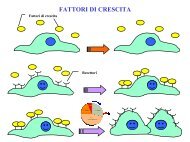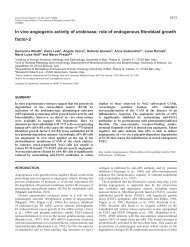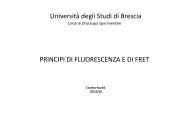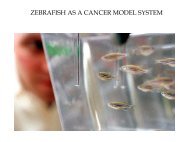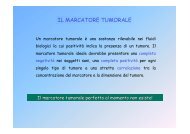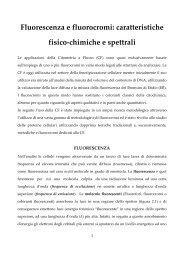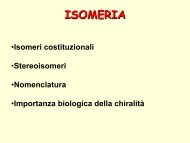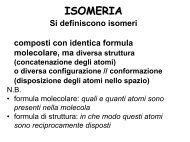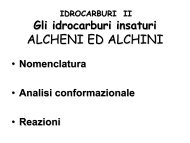Biological activity of substrate-bound basic fibroblast growth factor ...
Biological activity of substrate-bound basic fibroblast growth factor ...
Biological activity of substrate-bound basic fibroblast growth factor ...
You also want an ePaper? Increase the reach of your titles
YUMPU automatically turns print PDFs into web optimized ePapers that Google loves.
Oncogene (2002) 21, 3889 ± 3897<br />
ã 2002 Nature Publishing Group All rights reserved 0950 ± 9232/02 $25.00<br />
www.nature.com/onc<br />
<strong>Biological</strong> <strong>activity</strong> <strong>of</strong> <strong>substrate</strong>-<strong>bound</strong> <strong>basic</strong> ®broblast <strong>growth</strong> <strong>factor</strong><br />
(FGF2): recruitment <strong>of</strong> FGF receptor-1 in endothelial cell adhesion contacts<br />
Elena Tanghetti 1 , Roberto Ria 2 , Patrizia Dell'Era 1 , Chiara Urbinati 1 , Marco Rusnati 1 ,<br />
Maria Grazia Ennas 3 and Marco Presta* ,1<br />
1<br />
Unit <strong>of</strong> General Pathology and Immunology, Department <strong>of</strong> Biomedical Sciences and Biotechnology, School <strong>of</strong> Medicine,<br />
University <strong>of</strong> Brescia, Italy; 2 Department <strong>of</strong> Biomedical Sciences and Human Oncology, School <strong>of</strong> Medicine, University <strong>of</strong> Bari,<br />
Italy; 3 Department <strong>of</strong> Cytomorphology, University <strong>of</strong> Cagliari, Italy<br />
Substrate-<strong>bound</strong> FGF2 promotes endothelial cell adhesion<br />
by interacting with a v b 3 integrin. Here, endothelial<br />
GM7373 cells spread and organize focal adhesion plaques<br />
on immobilized FGF2, ®bronectin (FN), and vitronectin<br />
(VN). a v b 3 integrin, paxillin, focal adhesion kinase,<br />
vinculin and pp60 src localize in cell-substratum contact<br />
sites on FGF2, FN or VN. However, only immobilized<br />
FGF2 induces a long-lasting activation <strong>of</strong> extracellular<br />
signal-regulated kinases 1/2 (ERK 1/2 ) and cell proliferation<br />
that was inhibited by the ERK 1/2 inhibitor PD 098059 and<br />
the tyrosine kinase (TK) inhibitor tyrphostin 23, pointing<br />
to the engagement <strong>of</strong> FGF receptor (FGFR) at the basal<br />
side <strong>of</strong> the cell. To assess this hypothesis, GM7373 cells<br />
were transfected with a dominant negative TK 7 -DFGFR1<br />
mutant (GM7373-DFGFR1 cells) or with the full-length<br />
receptor (GM7373-FGFR1 cells). Both transfectants<br />
adhere and spread on FGF2 but GM7373-DFGFR1 cells<br />
do not proliferate. Also, parental and GM7373-FGFR1<br />
cells, but not GM7373-DFGFR1 cells, undergo morphological<br />
changes and increased motility on FGF2-coated<br />
plastic. Finally, FGFR1, but not TK 7 -DFGFR1, localizes<br />
in cell adhesion contacts on immobilized FGF2. In<br />
conclusion, <strong>substrate</strong>-<strong>bound</strong> FGF2 induces endothelial<br />
cell proliferation, motility, and the recruitment <strong>of</strong> FGFR1<br />
in cell-substratum contacts. This may contribute to the<br />
cross talk among intracellular signaling pathways<br />
activated by FGFR1 and a v b 3 integrin in endothelial cells.<br />
Oncogene (2002) 21, 3889 ± 3897. DOI: 10.1038/sj/<br />
onc/1205407<br />
Keywords: cell adhesion; cell proliferation; angiogenesis;<br />
integrin; FGF; tyrosine kinase; FGF receptor<br />
Introduction<br />
*Correspondence: M Presta, General Pathology, Dept. Biomedical<br />
Sciences and Biotechnology, Via Valsabbina 19, 25123 Brescia, Italy;<br />
E-mail: presta@med.unibs.it<br />
Received 21 June 2001; revised 8 February 2002; accepted 19<br />
February 2002<br />
Angiogenesis is a multi-step process that plays a key<br />
role in di€erent physiological and pathological conditions,<br />
including embryonic development, wound repair,<br />
in¯ammation, and tumor <strong>growth</strong> (Carmeliet and Jain,<br />
2000). It begins with the degradation <strong>of</strong> the basement<br />
membrane by activated endothelial cells that will<br />
migrate and proliferate, leading to the formation <strong>of</strong><br />
solid endothelial cell sprouts into the stromal space.<br />
Then, vascular loops are formed and capillary tubes<br />
develop with deposition <strong>of</strong> new basement membrane<br />
and accessory cell recruitment (Carmeliet, 2000). A<br />
close interaction exists among cell-adhesive proteins <strong>of</strong><br />
the extracellular matrix (ECM), their integrin receptors,<br />
and soluble angiogenesis <strong>growth</strong> <strong>factor</strong>s during<br />
each step <strong>of</strong> the angiogenesis process (Ingber and<br />
Folkman, 1989a,b; Davis et al., 1993; Brooks et al.,<br />
1994; Plopper et al., 1995).<br />
Basic ®broblast <strong>growth</strong> <strong>factor</strong> (FGF2) is one <strong>of</strong> the<br />
best characterized modulators <strong>of</strong> angiogenesis. FGF2<br />
induces neovascularization in vivo in di€erent experimental<br />
models (Basilico and Moscatelli, 1992) and is<br />
implicated in the <strong>growth</strong> <strong>of</strong> new blood vessels during<br />
wound healing and chick embryo development (Broadley<br />
et al., 1989; Ribatti et al., 1995). In vitro, FGF2<br />
induces cell proliferation, migration, and production <strong>of</strong><br />
proteases in endothelial cells (Moscatelli et al., 1986)<br />
by interacting with speci®c tyrosine-kinase (TK)<br />
receptors (FGFRs) and with heparan sulfate proteoglycans<br />
(HSPGs) <strong>of</strong> the cell surface (Johnson and<br />
Williams, 1993). Also, FGF2 modulates integrin<br />
expression in endothelium (Enenstein et al., 1992;<br />
Klein et al., 1993).<br />
Integrins are a family <strong>of</strong> transmembrane, heterodimeric<br />
adhesion receptors comprised <strong>of</strong> a and b<br />
subunits. The combination <strong>of</strong> di€erent subunits<br />
originates distinct integrin molecules that mediate cell<br />
adhesion to a variety <strong>of</strong> adhesive proteins <strong>of</strong> the ECM<br />
such as ®bronectin (FN), vitronectin (VN), thrombospondin,<br />
laminin and collagens (Albelda and Buck,<br />
1990; Hynes, 1992). Besides mediating cell adhesion,<br />
the interaction <strong>of</strong> integrins with cell-adhesive proteins<br />
plays a crucial role in regulating the response <strong>of</strong><br />
endothelial cells to soluble <strong>growth</strong> <strong>factor</strong>s, including<br />
FGF2 (Ingber and Folkman, 1989a,b; Stromblad and<br />
Cheresh, 1996). Also, a v b 3 integrin is highly expressed<br />
by endothelial cells during angiogenesis and is required<br />
to sustain neovascularization induced by FGF2
3890<br />
<strong>Biological</strong> <strong>activity</strong> <strong>of</strong> immobilized FGF2<br />
E Tanghetti et al<br />
(Brooks et al., 1994; Friedlander et al., 1995; Eliceiri et<br />
al., 1998). Interestingly, FGFRs, integrins, and intracellular<br />
transducers may co-localize in focal adhesion<br />
contacts (Plopper et al., 1995, Miyamoto et al.,<br />
1996). Despite these observations, the molecular<br />
mechanism(s) underlying the relationship between the<br />
FGF2/FGFR system and the cell adhesion machinery<br />
are not fully elucidated.<br />
Large amounts <strong>of</strong> FGF2 are present in ECM both in<br />
vivo and in vitro (Vlodavsky et al., 1987; Folkman et<br />
al., 1988). Collagen-<strong>bound</strong> FGF2 is mitogenically<br />
active in situ for BALB/c-3T3 ®broblasts (Smith et<br />
al., 1982) and FGF2 immobilized onto heparin-coated<br />
surfaces promotes endothelial cell adhesion (Baird et<br />
al., 1988) and PC12 cell adhesion and di€erentiation<br />
(Schubert et al., 1987). Thus, ECM-<strong>bound</strong> FGF2 may<br />
induce endothelial cell adhesion and act at the same<br />
time as a localized, persistent stimulus for angiogenesis<br />
by interacting with di€erent cell-surface molecules.<br />
Indeed, previous data obtained in our laboratory had<br />
shown that FGF2 interacts also with a v b 3 integrin and<br />
that this interaction mediates the capacity <strong>of</strong> the<br />
angiogenic <strong>growth</strong> <strong>factor</strong> to induce cell adhesion,<br />
mitogenesis, and urokinase-type plasminogen activator<br />
upregulation in endothelial cells (Rusnati et al., 1997).<br />
Interestingly, the endothelial cell-adhesive capacity <strong>of</strong><br />
FGF2 does not require the interaction <strong>of</strong> the <strong>growth</strong><br />
<strong>factor</strong> with FGFRs and/or HSPGs that are instead<br />
able to mediate a FGF2-dependent cell-cell interaction<br />
via the formation <strong>of</strong> a ternary FGFR/FGF2/HSPG<br />
complex (Richard et al., 1995).<br />
In the present study we investigated the molecular<br />
mechanisms mediating the mitogenic <strong>activity</strong> <strong>of</strong><br />
<strong>substrate</strong>-<strong>bound</strong> FGF2 in endothelial cells. The results<br />
demonstrate that immobilized FGF2 induces focal<br />
adhesion plaque formation and the activation <strong>of</strong><br />
extracellular signal-regulated kinases (ERK 1/2 ) in<br />
bovine aortic endothelial GM7373 cells. This is<br />
paralleled by a signi®cant increase in the proliferation<br />
rate <strong>of</strong> adherent cells. GM7373 cells transfected with a<br />
dominant negative, truncated TK 7 FGFR1 mutant<br />
adhere and spread but have lost the capacity to<br />
proliferate on immobilized FGF2. Intact FGFR1, but<br />
not the truncated receptor, localizes in the focal<br />
adhesion contacts induced by FGF2. These data shed<br />
a new light on the cross-talk between endothelial cell<br />
adhesion and proliferative events during angiogenesis.<br />
and the localization <strong>of</strong> vinculin (Figure 1B) and<br />
paxillin (not shown) demonstrate that immobilized<br />
FGF2 induces the formation <strong>of</strong> focal adhesion contacts<br />
in adherent GM7373 cells. Similar results were<br />
obtained for cells adherent to FN or VN (data not<br />
shown). Under the same experimental conditions, GM<br />
7373 cells attach (Figure 1A) but do not spread (not<br />
shown) on polylysine (PLL)-coated plastic.<br />
To con®rm these observations, GM7373 cells were<br />
seeded on FGF2, FN, VN, or PLL, allowed to adhere<br />
for 6 h, and stripped by PBS/EDTA washes (Culp,<br />
1976; Del Rosso et al., 1992). Cell-substratum contact<br />
sites, that represent 3 ± 4% <strong>of</strong> the surface membrane <strong>of</strong><br />
monolayered cells (Del Rosso et al., 1992), were then<br />
extracted and analyzed by Western blotting. As shown<br />
in Figure 2, FGF2-adherent plasma membrane remnants<br />
contain paxillin, a v b 3 integrin, focal adhesion<br />
kinase (FAK), and pp60 src . Similar results were<br />
obtained with cells adherent to FN and VN but not<br />
with cells adherent to PLL.<br />
Taken together the results demonstrate that immobilized<br />
FGF2 promotes focal adhesion plaque formation<br />
in endothelial cells with the recruitment <strong>of</strong> signal<br />
transducing molecules including FAK and pp60 src .<br />
Immobilized FGF2 induces endothelial cell proliferation<br />
Next, we evaluated the capacity <strong>of</strong> plastic-<strong>bound</strong> FGF2<br />
to promote cell proliferation in endothelial GM 7373<br />
cells. To this purpose, cells were allowed to adhere for<br />
2 h on di€erent substrata, including native or heatinactivated<br />
FGF2, FN, or VN. Then, non-adherent<br />
cells were removed and adherent cells were incubated<br />
in low serum. After a 24 h incubation, cells were<br />
trypsinized and counted. As shown in Figure 3, only<br />
immobilized native FGF2 is able to exert a rapid and<br />
signi®cant mitogenic response in adherent cells that<br />
Results<br />
Substrate-<strong>bound</strong> FGF-2 promotes focal adhesion plaque<br />
formation in endothelial cells<br />
Previous observations had shown that <strong>substrate</strong>-<strong>bound</strong><br />
FGF2 promotes endothelial cell adhesion via a v b 3<br />
integrin engagement (Rusnati et al., 1997). Accordingly,<br />
fetal bovine aortic endothelial GM 7373 cells<br />
adhere onto non-tissue culture plates coated with<br />
native or heat-inactivated FGF2, FN, or VN (Figure<br />
1A). Also, the distribution and organization <strong>of</strong> F-actin<br />
Figure 1 GM 7373 cell adhesion to FGF2-coated plastic. (A)<br />
Non tissue culture plastic plates were incubated with carbonate<br />
bu€er containing 20 mg/ml <strong>of</strong> BSA, FGF2, heat-inactivated FGF2<br />
(hi-FGF2), FN, VN, or PLL. GM 7373 cells were seeded onto<br />
coated plates and allowed to adhere for 2 h at 378C. Then, the<br />
number <strong>of</strong> adherent cells was evaluated. Each point is the<br />
mean+s.e.m. <strong>of</strong> three determinations in duplicate. (B) GM 7373<br />
cells adherent to immobilized FGF2 were stained with rodaminate-phalloidin<br />
(a) or anti-vinculin antibody (b)<br />
Oncogene
continue to proliferate for further 24 h. In contrast,<br />
FN adherent cell cultures showed a signi®cant increase<br />
in cell number only 72 h after seeding (Figure 3B). No<br />
proliferation was observed for cells seeded on plastic<br />
coated with heat-inactivated FGF2 (not shown) or<br />
BSA. It must be pointed out that no signi®cant<br />
di€erences in the levels <strong>of</strong> vascular endothelial <strong>growth</strong><br />
<strong>factor</strong> (ranging between 16 and 30 pg/ml) were detected<br />
by ELISA in the conditioned medium <strong>of</strong> GM 7373<br />
cells grown on the di€erent substrata.<br />
Downstream signaling triggered by the binding <strong>of</strong><br />
FGF2 to its TK + FGFRs encompasses the activation<br />
<strong>of</strong> mitogen-activated protein kinase kinase (MEK) with<br />
consequent phosphorylation <strong>of</strong> ERKs (Giuliani et al.,<br />
1999). Accordingly, a slow but long-lasting increase in<br />
<strong>Biological</strong> <strong>activity</strong> <strong>of</strong> immobilized FGF2<br />
E Tanghetti et al<br />
ERK 1/2<br />
phosphorylation was observed in GM7373<br />
cells seeded on immobilized FGF2 but not on<br />
immobilized FN (Figure 4A). Indeed, integrin engagement<br />
by FN is known to cause a rapid but transient<br />
activation <strong>of</strong> this signaling pathway (Miyamoto et al.,<br />
1996). The MEK inhibitor PD 098059 (Alessi et al.,<br />
1995) prevented ERK 1/2 activation whereas SB 210313,<br />
a selective inhibitor <strong>of</strong> p38 kinase (Cuenda et al., 1995),<br />
was ine€ective (Figure 4B). Accordingly, PD 098059<br />
inhibited the proliferation <strong>of</strong> GM7373 cells adherent to<br />
FGF2-coated plastic whereas SB 210313 was ine€ective<br />
(Figure 4D). The mitogenic response triggered by<br />
immobilized FGF2 was inhibited also by the TK<br />
inhibitor tyrphostin 23 (Boyer and Thiery, 1993), but<br />
not by tyrphostin 63 (Figure 4D) here used as a<br />
negative control (Gazit et al., 1989). None <strong>of</strong> the<br />
compounds tested was able to a€ect the adhesion <strong>of</strong><br />
GM7373 cells to immobilized FGF2 (Figure 4C).<br />
3891<br />
Figure 2 Western blot analysis <strong>of</strong> cell-substratum contact sites.<br />
GM 7373 cells were seeded onto plates coated with FGF2, FN,<br />
VN, or PLL and allowed to adhere for 6 h at 378C. Then cells<br />
were detached from the plastic with 3 mM EDTA/PBS washes.<br />
Plasma membrane remnants were washed three times with PBS<br />
and extracted. Aliquots (30 mg) <strong>of</strong> the extracted material were<br />
analysed by Western blotting with the indicated antibodies<br />
respect to cells adherent at T 0 population doublings in respect to cells adherent at T 0<br />
Figure 4 ERK 1/2 phosphorylation by immobilized FGF2. GM<br />
7373 cells were seeded onto FN- or FGF2-coated plastic. Western<br />
blot analysis <strong>of</strong> the cell extracts was performed 1 and 2 h after<br />
seeding using anti-phospho-ERK 1/2 antibodies (A). In B, cells<br />
were seeded on FGF2-coated plastic in the absence or in the<br />
presence <strong>of</strong> 50 mM SB 210313 (SB) or PD 098059 (PD). Western<br />
blot analysis <strong>of</strong> the cell extracts was performed 2 h after seeding<br />
using anti-phospho-ERK 1/2 antibodies. In parallel experiments,<br />
Figure 3 Mitogenic <strong>activity</strong> <strong>of</strong> immobilized FGF2. GM 7373 GM 7373 cells were seeded onto FGF2-coated plates in the<br />
cells were seeded onto plates coated with FGF2, heat-inactivated<br />
FGF2 (hi-FGF2), FN, or VN and allowed to adhere for 2 h at<br />
378C (T 0 ). Then, non-adherent cells were removed and adherent<br />
cells were incubated in fresh medium containing 0.4% FCS. Cells<br />
were trypsinized and counted 24 h (A) or 24, 48 and 72 h (B) after<br />
seeding. Data represent the mean+s.e.m. <strong>of</strong> three determinations<br />
in duplicate and are expressed as cell population doublings in<br />
absence or in the presence <strong>of</strong> 100 mM tyrphostin 23 (t23), 100 mM<br />
tyrphostin 63 (t63), 50 mM SB 210313 (SB) or 50 mM PD 098059<br />
(PD) and allowed to adhere for 2 h at 378C (T 0 ). Then, nonadherent<br />
cells were removed and adherent cells were counted<br />
immediately (C) or after a 24 h-incubation in fresh medium<br />
containing 0.4% FCS (D). Data represent the mean+s.e.m. <strong>of</strong><br />
three determinations in duplicate. In D, data are expressed as cell<br />
Oncogene
3892<br />
<strong>Biological</strong> <strong>activity</strong> <strong>of</strong> immobilized FGF2<br />
E Tanghetti et al<br />
Taken together, the data indicate that <strong>substrate</strong><strong>bound</strong><br />
FGF2 retains its mitogenic capacity that<br />
requires TK <strong>activity</strong> and ERK 1/2 phosphorylation.<br />
These observations raise the possibility that FGFR<br />
localized at the basal side <strong>of</strong> endothelial cells is<br />
involved in mediating the mitogenic response <strong>of</strong><br />
adherent cells to the immobilized <strong>growth</strong> <strong>factor</strong>.<br />
Figure 5 Expression <strong>of</strong> dominant negative DFGFR1 in GM<br />
7373 cells. GM 7373 cells were transfected with a retroviral<br />
expression vector harboring the full length TK + FGFR1 cDNA<br />
or the truncated TK 7 FGFR1 cDNA. Stable transfectants were<br />
isolated, generating GM7373-FGFR1 and GM7373-DFGFR1<br />
cells, respectively. Then, binding <strong>of</strong> 125 I-FGF2 to high anity<br />
receptors was evaluated as described in Materials and methods<br />
(A). Also, cell extracts were probed with anti-FGFR1 antibodies<br />
by Western blotting (B). In C, parental, GM7373-FGFR1, and<br />
GM7373-DFGFR1 cells were incubated for 20 min in the<br />
presence <strong>of</strong> the indicated concentrations <strong>of</strong> soluble FGF2. Then,<br />
Western blot analysis <strong>of</strong> the cell extracts was performed using<br />
anti-phospho-ERK 1/2 antibodies. a, parental GM 7373 cells; b,<br />
GM7373-DFGFR1 cells; c, GM7373-FGFR1 cells<br />
Dominant negative TK FGFR1 abolishes the response <strong>of</strong><br />
endothelial cells to immobilized FGF2<br />
To assess the role <strong>of</strong> FGFR in transducing a mitogenic<br />
signal in endothelial cells adherent to immobilized<br />
FGF2, GM 7373 cells were transfected with a mutated<br />
FGFR1 cDNA carrying a stop codon in the<br />
juxtamembrane domain. These cells, named GM7373-<br />
DFGFR1 cells, will express a dominant negative,<br />
truncated TK 7 DFGFR1 devoid <strong>of</strong> its TK domain<br />
and C-terminus (Li et al., 1994). In parallel, distinct<br />
GM7373 cell cultures were transfected with the full<br />
length TK + FGFR1 cDNA, thus generating GM7373-<br />
FGFR1 cells.<br />
As shown in Figure 5A, both GM7373-DFGFR1 and<br />
GM7373-FGFR1 cells binds 125 I-FGF2 with a capacity<br />
signi®cantly higher than that <strong>of</strong> parental cells. Western<br />
blot analysis <strong>of</strong> the cell extracts probed with a<br />
monoclonal anti-FGFR1 antibody evidenced the presence<br />
<strong>of</strong> a Mr 130 000 immunoreactive band in the cell<br />
extract <strong>of</strong> GM7373-FGFR1 cells (Figure 5B), corresponding<br />
to the full length receptor and comigrating<br />
with a fainter band present in the extract <strong>of</strong> parental<br />
cells. An intense Mr 90 000 immunoreative band,<br />
corresponding to the overexpressed truncated receptor,<br />
was instead detected in the cell extract <strong>of</strong> GM7373-<br />
DFGFR1 cells (Figure 5B). A signi®cant increase <strong>of</strong><br />
ERK 1/2 phosphorylation was detectable in parental and<br />
GM7373-FGFR1 cells adherent to tissue culture plastic<br />
and treated with soluble FGF2. No ERK 1/2 phosphorylation<br />
was instead detected in FGF2-treated GM7373-<br />
DFGFR1 cells, thus con®rming the dominant negative<br />
e€ect <strong>of</strong> the truncated TK 7 receptor (Figure 5C).<br />
GM7373-DFGFR1 and GM7373-FGFR1 cells adhere<br />
to immobilized FGF2, FN, or VN with an<br />
eciency similar to that shown by parental cells<br />
(Figure 6A). Also, their capacity to adhere to<br />
immobilized FGF2 was prevented by the highly speci®c<br />
monoclonal LM 609 antibody directed to a v b 3<br />
(Cheresh, 1987) (Figure 6A). Accordingly, all the cell<br />
lines express similar amounts <strong>of</strong> a v b 3 , as evidenced by<br />
Western blot analysis <strong>of</strong> the cell extracts (data not<br />
shown). However, GM7373-DFGFR1 cells have lost<br />
the ability to proliferate when seeded on FGF2-coated<br />
plastic; this ability is instead retained by GM7373-<br />
FGFR1 transfectants (Figure 6B). As observed for<br />
parental cells, GM7373-FGFR1 and GM7373-<br />
DFGFR1 cells do not proliferate when seeded on<br />
heat-inactivated FGF2, FN, or VN. It must be pointed<br />
out that no signi®cant di€erences were observed in the<br />
proliferation rate <strong>of</strong> the three cell lines when seeded on<br />
tissue culture plastic and maintained in 10% FCS (data<br />
not shown).<br />
Administration <strong>of</strong> FGF2 to the culture medium<br />
a€ects the appearance <strong>of</strong> endothelial cells that acquire<br />
an elongated, ®broblast-like morphology associated to<br />
increased cell motility (Tsuboi et al., 1990). Similarly,<br />
GM7373-FGFR1 cells adherent to FGF2-coated<br />
plastic took an elongated appearance with a crisscross<br />
pattern within 24 ± 48 h after seeding (Figure 7a,b).<br />
Also, crawling cells characterized by lamellipodia and<br />
microspikes at the leading edge were frequently<br />
observed (Figure 7c ± e). Similar even though less<br />
dramatic changes were observed 48 ± 72 h after seeding<br />
in parental GM 7373 cells adherent to immobilized<br />
FGF2 (data not shown), possibly re¯ecting the lower<br />
number <strong>of</strong> FGFR receptors expressed by parental cells<br />
in respect to the transfectants. In contrast, no<br />
morphological changes were observed in FGF2-<br />
adherent GM7373-DFGFR1 cells that retained a ¯atter<br />
cobblestone-like appearance throughout the whole<br />
experimental period (Figure 7f,g). Speci®city <strong>of</strong> the<br />
e€ect was demonstrated by the lack <strong>of</strong> <strong>activity</strong> <strong>of</strong><br />
immobilized FN (Figure 7h ± l) and VN (not shown)<br />
that did not in¯uence the morphological features <strong>of</strong><br />
adherent GM7373-FGFR1 and parental cells.<br />
Immobilized FGF2 recruits FGFR1 in cell-substratum<br />
contact sites<br />
The above data suggest that immobilized FGF2 can<br />
interact with FGFR1 at the basal side <strong>of</strong> the adherent<br />
Oncogene
<strong>Biological</strong> <strong>activity</strong> <strong>of</strong> immobilized FGF2<br />
E Tanghetti et al<br />
3893<br />
Figure 6 E€ect <strong>of</strong> dominant negative DFGFR1 on the mitogenic <strong>activity</strong> <strong>of</strong> immobilized FGF2. Parental, GM7373-FGFR1, and<br />
GM7373-DFGFR1 cells were seeded onto plastic coated with BSA, FGF2 (in the absence or in the presence <strong>of</strong> monoclonal LM609<br />
anti-a v b 3 antibody), heat-inactivated FGF2, FN, or VN and allowed to adhere for 2 h at 378C (T 0 ). Then, non-adherent cells were<br />
removed and adherent cells were counted immediately (A) or after a 24 h-incubation in fresh medium containing 0.4% FCS (B).<br />
Data represent the mean+s.e.m. <strong>of</strong> three determinations in duplicate. In B, data are expressed as cell population doublings in<br />
respect to cells adherent at T 0<br />
cells, thus triggering a mitogenic and morphogenic<br />
response. Accordingly, FGFR1 and paxillin co-localize<br />
in GM 7373 cells adherent to immobilized FGF2<br />
(Figure 8A). Also, Western blot analysis <strong>of</strong> cellsubstratum<br />
contact sites organized by GM7373-<br />
FGFR1 transfectants adherent to FGF2-coated plastic<br />
demonstrates the presence <strong>of</strong> FGFR1 in this plasma<br />
membrane fraction (Figure 8B). Semi-quantitative<br />
Western blot analysis indicates that more than 50%<br />
<strong>of</strong> the total amount <strong>of</strong> FGFR1 accumulates in this<br />
fraction. No FGFR1 was detected in contacts formed<br />
by GM7373-FGFR1 cells adherent to FN.<br />
To con®rm that the interaction with immobilized<br />
FGF2 causes a redistribution <strong>of</strong> FGFR1 at the basal<br />
side <strong>of</strong> the cell, GM7373-FGFR1 cells were seeded in<br />
96-well plates at 75 000 cells/cm 2 on tissue culture<br />
plastic or on plastic coated with FGF2 or FN. After<br />
6 h, adherent cell monolayers were incubated for 2 h at<br />
48C with 125 I-FGF2 (10 ng/ml) and its binding to high<br />
anity FGFRs was evaluated (Rusnati et al., 1996).<br />
FGF2-adherent cells showed a signi®cant reduction in<br />
the capacity to bind 125 I-FGF2 at the apical side <strong>of</strong> the<br />
cell monolayer (5+2 c.p.m./well) when compared to<br />
cells adherent to FN (151+20 c.p.m./well) or to tissue<br />
culture plastic (225+30 c.p.m./well) (n=3). This occurs<br />
in the absence <strong>of</strong> signi®cant di€erences in the total<br />
amount <strong>of</strong> FGFR1 expressed by these cells under the<br />
various experimental conditions, as shown by Western<br />
blot analysis <strong>of</strong> the cell extracts with anti-FGFR1<br />
antibodies (data not shown).<br />
No truncated DFGFR1 accumulates in contacts<br />
organized by GM7373-DFGFR1 adherent to immobilized<br />
FGF2 (Figure 8b) despite the high levels <strong>of</strong><br />
expression <strong>of</strong> the receptor in these cells (see Figure 5).<br />
These data indicate that the recruitment <strong>of</strong> FGFR1 by<br />
immobilized FGF2 is speci®c and that the interaction<br />
<strong>of</strong> FGF2 with the extracellular domain <strong>of</strong> the receptor<br />
is not sucient for its cooption in the adhesion<br />
contacts. Accordingly, the TK inhibitor tyrphostin 23<br />
prevented the recruitment <strong>of</strong> intact FGFR1 and caused<br />
a decrease in the amount <strong>of</strong> pp60 src in focal contacts <strong>of</strong><br />
GM7373-FGFR1 transfectants adherent to immobilized<br />
FGF2. No e€ect was instead exerted by<br />
tyrphostin 63 (Figure 9).<br />
Taken together the data indicate that immobilized<br />
FGF2 is able to recruit FGFR1 in cell adhesion<br />
contacts <strong>of</strong> adherent GM7373 cells. The intracellular<br />
domain and/or the TK <strong>activity</strong> <strong>of</strong> the receptor are<br />
required for its cooption in these structures.<br />
Discussion<br />
Immobilized FGF2 interacts with a v b 3 integrin and<br />
promotes endothelial cell adhesion and spreading<br />
(Rusnati et al., 1997). Our results demonstrate that<br />
<strong>substrate</strong>-<strong>bound</strong> FGF2 retains its biological <strong>activity</strong>,<br />
stimulating ERK 1/2 phosphorylation, cell proliferation,<br />
and motility in adherent endothelial GM7373 cells.<br />
This is paralleled by the recruitment <strong>of</strong> FGFR1 in cellsubstratum<br />
contact sites. Overexpression <strong>of</strong> the<br />
dominant negative TK 7 DFGFR1, treatment with the<br />
TK inhibitor tyrphostin 23, or treatment with the<br />
MEK inhibitor PD 098059 inhibit the mitogenic<br />
<strong>activity</strong> <strong>of</strong> immobilized FGF2 without a€ecting a v b 3 -<br />
mediated cell adhesion.<br />
ECM may act as a physiological reservoir for<br />
extracellular FGF2 (Vlodavsky et al., 1987; Folkman<br />
et al., 1988). Various enzymes, including heparanase,<br />
thrombin, collagenases, plasmin, and urokinase-type<br />
Oncogene
3894<br />
<strong>Biological</strong> <strong>activity</strong> <strong>of</strong> immobilized FGF2<br />
E Tanghetti et al<br />
Figure 8 FGFR1 recruitment in cell-substratum contact sites.<br />
(A) GM 7373 cells adherent to immobilized FGF2 were<br />
immunostained with anti-FGFR1 (A) and anti-paxillin (B)<br />
antibodies. FGFR1 co-localizes in paxillin-positive focal adhesion<br />
contacts (arrowheads). (B) GM7373-FGFR1 and GM7373-<br />
DFGFR1 cells were seeded onto plates coated with FGF2, FN,<br />
or PLL and allowed to adhere for 6 h at 378C. Then cells were<br />
detached from the plastic with 3 mM EDTA/PBS washes. Plasma<br />
membrane remnants were washed three times with PBS and<br />
extracted. Aliquots (30 mg) <strong>of</strong> the extracted material were<br />
analysed by Western blotting with antibodies directed against<br />
vinculin or FGFR1. The anticipated position corresponding to<br />
DFGFR1 migration is also indicated<br />
Figure 7 Morphology <strong>of</strong> GM7373-FGFR1 cells adherent to<br />
immobilized FGF2. GM7373-FGFR1 cells (a ± e, h ± l) and<br />
GM7373-DFGFR1 cells (f, g) were allowed to adhere onto glass<br />
coverslips coated with 20 mg/ml <strong>of</strong> FGF2 (a±g)orFN(i, l). After<br />
48 h, cells were ®xed and photographed under a phase contrast<br />
inverted microscope at 406 magni®cation (a, f, h), processed for<br />
scanning electron microscopy and photographed at 8006 (b),<br />
3006 (c, g), 20006 (d), or 6006 (i) magni®cation, or stained<br />
with rodaminate-phalloidin and photographed at 6306 magni®cation<br />
(e, l). Note the elongated shape and crisscross pattern <strong>of</strong><br />
GM7373-FGFR1 cells adherent to FGF2 (a, b, e) when compared<br />
to the ¯atter and more regular appearance <strong>of</strong> FN-adherent cells<br />
(h±l) and <strong>of</strong> FGF2-adherent GM7373-DFGFR1 cells (f, g). In c,<br />
GM7373-FGFR1 cells migrate onto the FGF2-coated substratum<br />
(white boxed enlarged in c showing a crawling cell characterized<br />
by lamellipodia and microspikes at the leading edge, also evident<br />
in e after rodaminate-phalloidin staining)<br />
plasminogen activator release ECM-<strong>bound</strong> FGF2<br />
(Ribatti et al., 1999, and references therein) suggesting<br />
that the balance between storage and release <strong>of</strong><br />
FGF2 in ECM, as well as the integrity <strong>of</strong> the matrix,<br />
may regulate the biological e€ects <strong>of</strong> this <strong>growth</strong><br />
<strong>factor</strong> on endothelium. On the other hand, collagen<strong>bound</strong><br />
FGF2 is mitogenically active in situ for<br />
BALB/c-3T3 ®broblasts (Smith et al., 1982) and<br />
FGF2 immobilized onto heparin-coated surfaces<br />
promotes endothelial cell adhesion (Baird et al.,<br />
1988) and PC12 cell adhesion and di€erentiation<br />
(Schubert et al., 1987). Our ®ndings extend these<br />
Figure 9 TK <strong>activity</strong> is required for FGFR1 recruitment in cellsubstratum<br />
contact sites. GM7373-FGFR1 cells were seeded onto<br />
FGF2-coated plates and allowed to adhere for 6 h at 378C in the<br />
absence or in the presence <strong>of</strong> 100 mM tyrphostin 63 (t63) or<br />
tyrphostin 23 (t23). Then cells were detached from the plastic with<br />
3mM EDTA/PBS washes. Plasma membrane remnants were<br />
washed three times with PBS and extracted. Aliquots (30 mg) <strong>of</strong><br />
the extracted material were analysed by Western blotting with<br />
antibodies directed against the indicated proteins<br />
observations and demonstrate that endothelial cells<br />
adherent to FGF2 proliferate and acquire a migra-<br />
Oncogene
<strong>Biological</strong> <strong>activity</strong> <strong>of</strong> immobilized FGF2<br />
E Tanghetti et al<br />
tory phenotype. FGF2 <strong>bound</strong> to plastic resists to<br />
extraction with urea, methanol, or ethanol and it is<br />
removed only by drastic treatment with detergents<br />
like Triton X-100 or SDS (Smith et al., 1982;<br />
Rusnati et al., 1997). Accordingly, no FGF2<br />
internalization was observed in cells adherent to<br />
FGF2-coated plastic in which 125 I-FGF2 was used<br />
as a tracer (M Rusnati, unpublished observations).<br />
These data indicate that FGF2 may represent an<br />
angiogenic stimulus also when tightly <strong>bound</strong> to the<br />
substratum.<br />
Under our experimental conditions the amount <strong>of</strong><br />
FGF2 <strong>bound</strong> to non-tissue culture plastic corresponds<br />
to 10 12 molecules/cm 2 (Rusnati et al., 1997). Thus, each<br />
endothelial cell adheres onto approximately 10 7<br />
molecules <strong>of</strong> immobilized FGF2. This causes the<br />
a v b 3 -mediated formation <strong>of</strong> focal adhesion contacts<br />
and actin cytoskeletal organization. The analysis <strong>of</strong> the<br />
components <strong>of</strong> the cell-substratum contact sites indicates<br />
that immobilized FGF2 activates the all series<br />
<strong>of</strong> speci®c stages <strong>of</strong> hierarchies <strong>of</strong> protein interactions<br />
that occur during integrin response, as observed for<br />
typical cell-adhesion proteins like FN and VN<br />
(Miyamoto et al., 1995). Indeed, the presence <strong>of</strong> a v b 3<br />
integrin, FAK, vinculin, pp60 src , and paxillin in cellsubstratum<br />
contact sites demonstrate that immobilized<br />
FGF2 is able to cause integrin receptor aggregation,<br />
integrin occupancy, cytoplasmic tyrosine phosphorylation,<br />
and actin cytoskeletal organization (Miyamoto et<br />
al., 1995).<br />
As stated above, endothelial cell adhesion to<br />
immobilized FGF2 is followed by a rapid and<br />
signi®cant increase in cell proliferation. However,<br />
integrin engagement is not sucient per seÁ to trigger<br />
a mitogenic response. Indeed, GM 7373 cells adhere<br />
and spread also on heat-inactivated FGF2, FN, or VN<br />
leading to the formation <strong>of</strong> focal adhesion contacts in<br />
the absence <strong>of</strong> a signi®cant increase <strong>of</strong> their rate <strong>of</strong><br />
proliferation that occurs only at late time points.<br />
Conversely, overexpression <strong>of</strong> the dominant negative<br />
DFGFR1, tyrphostin 23, and PD 098059 completely<br />
abolish the mitogenic response to immobilized FGF2<br />
without a€ecting a v b 3 -mediated cell adhesion. Moreover,<br />
neutralizing anti-a v b 3 monoclonal and polyclonal<br />
antibodies do inhibit cell proliferation induced by<br />
soluble FGF2 in GM 7373 cells grown on tissue<br />
culture plastic (Rusnati et al., 1997). Thus, interaction<br />
<strong>of</strong> FGF2 with a v b 3 integrin is necessary but not<br />
sucient to transduce a mitogenic signal that requires<br />
the activation <strong>of</strong> a functional TK + FGFR.<br />
Previous observations had shown that integrin<br />
clustering at sites <strong>of</strong> contact <strong>of</strong> FN-coated beads with<br />
®broblast cell surface is accompanied by a transient<br />
accumulation <strong>of</strong> various <strong>growth</strong> <strong>factor</strong> TK receptors,<br />
including FGFR1 (Miyamoto et al., 1996). Here we<br />
show that immobilized FGF2, but not immobilized<br />
FN or PLL, triggers a long-lasting accumulation <strong>of</strong><br />
FGFR1 at the cell-substratum contact sites <strong>of</strong><br />
adherent GM7373-FGFR1 transfectants. Six hours<br />
after adhesion, cell-substratum contact sites, that<br />
represent 3 ± 4% <strong>of</strong> the surface membrane <strong>of</strong> monolayered<br />
cells (Del Rosso et al., 1992), contain more<br />
than 50% <strong>of</strong> total FGFR1 molecules, clearly indicating<br />
that the interaction with immobilized FGF2<br />
concentrates the receptor in these cell membrane<br />
remnants. Accordingly, FGF2-adherent cells showed<br />
a dramatic reduction in the number <strong>of</strong> high anity<br />
125<br />
I-FGF2 binding sites present on the apical side <strong>of</strong><br />
the cell monolayer when compared to cells adherent to<br />
FN or to tissue culture plastic, thus con®rming that<br />
interaction with immobilized FGF2 causes a redistribution<br />
<strong>of</strong> FGFRs at the basal side <strong>of</strong> the cell.<br />
Interestingly, the truncated receptor overexpressed by<br />
GM7373-DFGFR1 cells does not accumulate in<br />
FGF2-induced contact sites, despite its ability to bind<br />
FGF2 in a manner undistinguishable from the wildtype<br />
receptor. Thus, the interaction <strong>of</strong> the extracellular<br />
domain <strong>of</strong> the receptor with the immobilized <strong>growth</strong><br />
<strong>factor</strong> is not sucient to guarantee a long-lasting<br />
accumulation <strong>of</strong> FGFR1 in the focal adhesion<br />
contacts that may require the activation <strong>of</strong> the<br />
intracellular TK moiety <strong>of</strong> the receptor and/or its<br />
interaction with other intracellular proteins. The<br />
ability <strong>of</strong> tyrphostin 23 to prevent FGFR1 recruitment<br />
and the capacity <strong>of</strong> FGFR1 to associate with pp60 src<br />
and cortactin (Zhan et al., 1994) support this<br />
hypothesis. Recently, the vascular endothelial <strong>growth</strong><br />
<strong>factor</strong> receptor VEGFR2/KDR has been shown to<br />
interact directly with a v b 3 integrin (Soldi et al., 1999).<br />
By using the same experimental approaches, we have<br />
been unable to observe a direct interaction between<br />
FGFR1 and a v b 3 integrin (E Tanghetti, unpublished<br />
data). The dissection <strong>of</strong> the molecular basis <strong>of</strong><br />
FGFR1 recruitment in cell-substratum contact sites<br />
by immobilized FGF2 will require further investigation.<br />
Previous observations had implicated ERK activation<br />
in FGF2 signaling (Besser et al., 1995; Giuliani et<br />
al., 1999) and angiogenesis (Eliceiri et al., 1998). FGF2<br />
causes a long-lasting phosphorylation <strong>of</strong> ERK 1/2 in<br />
parental and GM7373-FGFR1 cells, but not in<br />
GM7373-DFGFR1 transfectants. Also, the MEK<br />
inhibitor PD 098059 prevents the mitogenic response<br />
<strong>of</strong> parental and GM7373-FGFR1 cells to immobilized<br />
FGF2. These data emphasize the role <strong>of</strong> ERK 1/2 in<br />
signal transduction activated by FGFR1 occupancy in<br />
endothelium.<br />
Several experimental evidences support the hypothesis<br />
that integrins collaborate with TK receptors in<br />
transducing the intracellular signals triggered by<br />
<strong>growth</strong> <strong>factor</strong>s in target cells (Miyamoto, 1995, 1996;<br />
Kumar, 1998; Giancotti and Rouslathi, 1999). We<br />
report here that immobilized FGF2 interacts with a v b 3<br />
integrin and FGFR1, a€ecting di€erent aspects <strong>of</strong> the<br />
angiogenic phenotype <strong>of</strong> endothelial cells, including cell<br />
adhesion, proliferation, morphogenesis, and motility.<br />
Our data indicate that FGFR1 and a v b 3 integrin may<br />
be favored in their cross-talk by the long-lasting<br />
structural vicinity that occur at the basal aspect <strong>of</strong><br />
the endothelium where they colocalize in cell-substratum<br />
contact sites after adhesion onto immobilized<br />
FGF2.<br />
3895<br />
Oncogene
3896<br />
Materials and methods<br />
<strong>Biological</strong> <strong>activity</strong> <strong>of</strong> immobilized FGF2<br />
E Tanghetti et al<br />
Materials<br />
Human recombinant FGF2 was expressed and puri®ed from<br />
transformed E. coli cells as described (Isacchi et al., 1991).<br />
Anti-a v b 3 monoclonal LM 609 antibody was from Chemicon<br />
International (Temecula, CA, USA). For Western blotting,<br />
monoclonal anti-FGFR1 antibody and polyclonal antipp60<br />
src antibody were from Upstate Biotechnology (Lake<br />
Placid, NY, USA) and Santa Cruz Biotechnology (Santa<br />
Cruz, CA, USA), respectively. PD 098059 and SB 210313<br />
were from Calbiochem (San Diego, CA, USA) and RBI<br />
(Natick, MA, USA), respectively. PLL, tyrphostin 23,<br />
tyrphostin 63, rodaminate-phalloidin, and anti-vinculin antibody<br />
were from Sigma (St. Louis, MO, USA). Monoclonal<br />
anti-FAK antibody was a gift from G Tarone (University <strong>of</strong><br />
Turin, Italy). Bovine FN was from Harbor Bio-Products<br />
(Norwood, MA, USA) and human VN was from Becton<br />
Dickinson Labware (Bedford, MA, USA).<br />
Cell cultures and transfection<br />
Fetal bovine aortic endothelial GM 7373 cells, corresponding<br />
to the BFA-1c multilayered transformed clone (Grinspan et<br />
al., 1983), were grown in Eagle's minimal essential medium<br />
(MEM) containing 10% FCS, vitamins, essential and non<br />
essential amino acids.<br />
Plasmids 91023b-¯g (murine IIIc variant <strong>of</strong> FGFR-1<br />
cDNA), pCEP4-¯g 1.2 (truncated murine IIIc variant <strong>of</strong><br />
FGFR-1 cDNA) and pCB7 (a plasmid that carries the neo r<br />
gene) were provided by A Mansukhani and C Basilico (New<br />
York University Medical Center, New York, NY, USA).<br />
GM7373 cells were transfected with 91023b-¯g in association<br />
(10 : 1, wt:wt) with pCB7 according to a calcium phosphate<br />
precipitation protocol as described (Rusnati et al., 1996) and<br />
selected with 250 mg/ml <strong>of</strong> G418 (Sigma, St. Louis, MO,<br />
USA). Parallel cultures were transfected with pCEP4-¯g 1.2<br />
and selected with 200 mg/ml <strong>of</strong> hygromycin B (Boehringer<br />
Mannheim GmbH, Mannheim). For each transfection,<br />
resistant clones were tested for 125 I-FGF2 binding capacity<br />
(Rusnati et al., 1996) and by Western blotting using anti-<br />
FGFR1 antibody (Upstate Biotechnology, Lake Placid, NY,<br />
USA).<br />
Cell adhesion assay<br />
One hundred ml aliquots <strong>of</strong> 100 mM NaHCO 3 , pH 9.6<br />
(carbonate bu€er), containing the adhesive molecule under<br />
test were added to polystyrene non-tissue culture microtiter<br />
plates. After 16 h <strong>of</strong> incubation at 48C the solution was<br />
removed and wells were washed three times with cold<br />
phosphate bu€ered saline (PBS). Then, wells were incubated<br />
for 1 h at 378C with 1.0 mg/ml BSA and washed<br />
extensively with PBS. For the cell-adhesion assay, con¯uent<br />
cultures <strong>of</strong> GM 7373 cells were trypsinized, washed and<br />
resuspended with the appropriate medium. Previous observations<br />
had indicated that low concentrations <strong>of</strong> serum<br />
were required in some experiments for optimal cell<br />
adhesion to FGF2-coated plastic (Rusnati et al., 1997).<br />
For this reason, 1% FCS was utilized routinely in celladhesion<br />
experiments. Fifty thousand GM 7373 cells were<br />
resuspended in 200 ml <strong>of</strong> medium and were immediately<br />
seeded onto wells coated with the molecule under test.<br />
Routinely, cell-adhesion was allowed to occur for 2 h at<br />
378C. Then, wells were washed with 2 mM EDTA/PBS.<br />
Adherent cells were trypsinized and counted.<br />
Western blot analysis <strong>of</strong> cell-substratum contact sites<br />
Cells were seeded at 75 000 cells/cm 2 on plastic coated with<br />
the di€erent substrata. After 6 h, cells were detached from<br />
the plastic with 3 mM EDTA/PBS (Del Rosso et al., 1992).<br />
The material remaining on the plastic, representing plasma<br />
membrane remnants, was washed three times with PBS and<br />
extracted with 0.1 M Tris-HCl (pH 8.1) containing 1 mM<br />
PMSF, 0.2% sodium-deoxycholate, 1% Triton-X100. Aliquots<br />
(30 mg) <strong>of</strong> the extracted material were analysed by<br />
Western blotting with the indicated antibodies.<br />
Evaluation <strong>of</strong> the mitogenic <strong>activity</strong> <strong>of</strong> immobilized FGF2<br />
Parental and transfected GM7373 cells were seeded at<br />
130 000 cells/cm 2 onto 96-well plates coated with the di€erent<br />
substrata and incubated for 2 h at 378C with MEM<br />
containing 1% FCS. Then, cells were washed with 2 mM<br />
EDTA/PBS (T 0 ). Adherent cells were incubated for further<br />
24, 48 or 72 h in fresh MEM containing 0.4% FCS. In some<br />
experiments, medium was added with di€erent inhibitors. At<br />
the end <strong>of</strong> incubation, cells were trypsinized and counted in a<br />
Burker chamber. Data are expressed as cell population<br />
doublings in respect to cells adherent at T 0 .<br />
Western blot analysis <strong>of</strong> ERK 1/2 phosphorylation<br />
Parental and transfected GM7373 cells were seeded at 42 000<br />
cells/cm 2 in 35 mm tissue culture dishes. After adhesion, cells<br />
were incubated in serum-free MEM added with 10 mg/ml<br />
transferrin and 1 mg/ml BSA. After 24 h, cells were<br />
incubated for 20 min at 378C with no addition or 2.0 or<br />
10.0 ng/ml FGF2. Then, Western blot analysis <strong>of</strong> the cell<br />
extracts was performed as described (Besser et al., 1995)<br />
using anti-phospho-ERK 1/2 antibody (New England Biolabs,<br />
Inc., Beverly, MA, USA).<br />
In some experiments, GM7373 cells were seeded at 90 000<br />
cells/cm 2 in 35 mm dishes coated with FGF2 or FN in the<br />
absence or in the presence <strong>of</strong> 50 mM PD 098059 or SB<br />
210313. After 1 or 2 h, cell extracts were analysed for ERK 1/2<br />
phosphorylation as above.<br />
For all the experiments, equal loading <strong>of</strong> the di€erent lanes<br />
<strong>of</strong> the gel were con®rmed by Western blotting <strong>of</strong> the stripped<br />
membranes with anti-ERK 1/2 antibody (not shown).<br />
Immunocytochemistry<br />
Cells were seeded onto FGF2- or FN-coated glass coverslips<br />
in MEM added with 1% FCS. After 2 ± 6 h, cells were<br />
washed, ®xed in 3% paraformaldehyde, 2% sucrose in PBS,<br />
permeabilized with 0.5% Triton-X100, and saturated with<br />
3% BSA in PBS. Then, in a ®rst set <strong>of</strong> experiments, cells<br />
were incubated with monoclonal anti-vinculin antibody<br />
followed by ¯uorescinated anti-mouse IgG plus rodaminatephalloidin.<br />
In a second set <strong>of</strong> experiments, cells were<br />
incubated with monoclonal anti-paxillin antibody (Transduction<br />
Laboratories, Lexington, KY, USA) followed by Alexa<br />
Fluor 594 anti-mouse IgG (Molecular Probes, Eugene, OR,<br />
USA) and polyclonal anti-FGFR1 antibody (Santa Cruz<br />
Biotechnology) followed by biotinylated swine anti-rabbit<br />
IgG (Dako, Glostrup, Denmark) and rhodol green conjugated<br />
streptavidin (Molecular Probes).<br />
Scanning electron microscopy<br />
Glass coverslips (10 mm in diameter) were placed within<br />
24-well tissue culture plates and coated overnight at 48C<br />
Oncogene
with carbonate bu€er containing 20 mg/ml <strong>of</strong> FGF2, FN,<br />
or VN. Then, plates were washed three times with cold<br />
PBS. Cells were seeded at 130 000/cm 2 and allowed to<br />
adhere onto glass coverslips for 2 h in MEM added with<br />
1% FCS. Then, cells were washed with 2 mM EDTA in<br />
PBS. Adherent cells were incubated for further 24 ± 72 h in<br />
fresh MEM containing 0.4% FCS. Cells were then ®xed<br />
with 1.5% glutaraldehyde, 1% paraformaldehyde in 0.15 M<br />
cacodylate bu€er (pH 7.4) for 1 h. Coverslips were then<br />
washed, dehydrated, critical point dried with CO 2 and<br />
sputter coated with 3.2 nM platinum with Emitech K575<br />
apparatus (Emitech, UK). Cells were then viewed under<br />
Hitachi scanning electron microscope ®nd emission mod.<br />
<strong>Biological</strong> <strong>activity</strong> <strong>of</strong> immobilized FGF2<br />
E Tanghetti et al<br />
S4000 (Hitachi, Japan) operated at 15 kV and photographed.<br />
Acknowledgments<br />
This work was supported by MURST (60% and Co®n<br />
2000 to M Rusnati and to M Presta.; Centro di Eccellenza<br />
`IDET' to M Presta), CNR (Progetto Finalizzato Biotecnologie),<br />
Associazione Italiana per la Ricerca sul Cancro,<br />
Istituto Superiore di SanitaÁ (AIDS Project), and Centro per<br />
lo Studio del Trattamento dello Scompenso Cardiaco<br />
(University <strong>of</strong> Brescia) to M Presta<br />
3897<br />
References<br />
Albelda SM and Buck CA. (1990). FASEB J., 4, 2868 ±<br />
2880.<br />
Alessi DR, Cuenda A, Cohen P, Dudley DT and Saltiel AR.<br />
(1995). J. Biol. Chem., 270, 27489 ± 27494.<br />
Baird A, Schubert D, Ling N and Guillemin R. (1988). Proc.<br />
Natl. Acad. Sci. USA, 85, 2324 ± 2328.<br />
Basilico C and Moscatelli D. (1992). Adv. Cancer Res., 59,<br />
115 ± 165.<br />
Besser D, Presta M and Nagamine Y. (1995). Cell Growth<br />
Di€er., 6, 1009 ± 1017.<br />
Boyer B and Thiery JP. (1993). J. Cell Biol., 120, 767 ± 776.<br />
Broadley KN, Aquino AM, Woodward SC, Buckley-<br />
Sturrock A, Sato Y, Rifkin DB and Davidson JM.<br />
(1989). Lab. Invest., 61, 571 ± 575.<br />
Brooks PC, Richard AF and Cheresh DA. (1994). Science,<br />
264, 569 ± 571.<br />
Carmeliet P. (2000). Nature Med., 6, 389 ± 395.<br />
Carmeliet P and Jain RK. (2000). Nature, 407, 249 ± 257.<br />
Cheresh DA. (1987). Proc. Natl. Acad. Sci. USA, 84, 6471 ±<br />
6475.<br />
Cuenda A, Rouse J, Doza YN, Meier R, Cohen P, Gallagher<br />
TF, Young PR and Lee JC. (1995). FEBS Lett., 364, 229 ±<br />
233.<br />
Culp LA. (1976). Biochemistry, 15, 4094 ± 4104.<br />
Davis CM, Danehower SC, Laurenza A and Molony JL.<br />
(1993). J. Cell. Biochem., 51, 206 ± 218.<br />
Del Rosso M, Pedersen N, Fibbi G, Pucci M, Dini G,<br />
Anichini E and Blasi F. (1992). Exp. Cell Res., 203, 427 ±<br />
434.<br />
Eliceiri BP, Klemke R, Stromblad S and Cheresh DA. (1998).<br />
J. Cell Biol., 140, 1255 ± 1263.<br />
Enenstein J, Waleh NS and Kramer RH. (1992). Exp. Cell<br />
Res., 203, 499 ± 503.<br />
Folkman J, Klagsbrun M, Sasse J, Wadzinsky M, Ingber D<br />
and Vlodavsky I. (1988). Am. J. Pathol., 130, 393 ± 400.<br />
Friedlander M, Brooks PC, Sha€er RW, Kincaid CM,<br />
Varner JA and Cheresh DA. (1995). Science, 270, 1500 ±<br />
1502.<br />
Gazit A, Yaish P, Gilon C and Levitzki A. (1989). J. Biol.<br />
Chem., 264, 14503 ± 14509.<br />
Giancotti FG and Rouslathi E. (1999). Science, 285, 1028 ±<br />
1032.<br />
Giuliani R, Bastaki M, Coltrini D and Presta M. (1999). J.<br />
Cell Sci., 112, 2597 ± 2606.<br />
Grinspan JB, Stephen NM and Levine EM. (1983). J. Cell<br />
Physiol., 114, 328 ± 338.<br />
Hynes RO. (1992). Cell, 69, 11 ± 25.<br />
Ingber DE and Folkman J. (1989a). Cell, 58, 803 ± 805.<br />
Ingber DE and Folkman J. (1989b). J. Cell Biol., 109, 317 ±<br />
330.<br />
Isacchi A, Statuto M, Chiesa R, Bergonzoni L, Rusnati M,<br />
Sarmientos P, Ragnotti G and Presta M. (1991). Proc.<br />
Natl. Acad. Sci. USA, 88, 2628 ± 2632.<br />
Johnson DE and Williams LT. (1993). Adv. Cancer Res., 60,<br />
1±41.<br />
KleinS,GiancottiFG,PrestaM,AlbeldaSM,ClaytonAB<br />
and Rifkin DB. (1993). Mol. Biol. Cell, 4, 973 ± 982.<br />
Kumar CC. (1998). Oncogene, 17, 1365 ± 1373.<br />
Li Y, Basilico C and Mansukhani A. (1994). Mol. Cell Biol.,<br />
14, 7600 ± 7669.<br />
Miyamoto S, Teramoto H, Coso OA, Gutkind JS, Burbelo<br />
PD, Akiyama SK and Yamada KM. (1995). J. Cell Biol.,<br />
131, 791 ± 805.<br />
Miyamoto S, Teramoto H, Gutkind JS and Yamada KM.<br />
(1996). J. Cell Biol., 135, 1633 ± 1642.<br />
Moscatelli D, Presta M and Rifkin DB. (1986). Proc. Natl.<br />
Acad.Sci.USA,83, 2091 ± 2095.<br />
Plopper GE, McNamee HP, Dike LE, Bojanowski K and<br />
Ingber DE. (1995). Mol. Biol. Cell, 6, 1349 ± 1365.<br />
Ribatti D, Urbinati C, Nico B, Rusnati M, Roncali L and<br />
Presta M. (1995). Dev. Biol., 170, 39 ± 49.<br />
Ribatti D, Leali D, Vacca A, Giuliani R, Gualandris A,<br />
Roncali L, Nolli ML and Presta M. (1999). J. Cell Sci.,<br />
112, 4213 ± 4221.<br />
Richard C, Liuzzo JP and Moscatelli D. (1995). J. Biol.<br />
Chem., 270, 24188 ± 24196.<br />
RusnatiM,Dell'EraP,UrbinatiC,TanghettiE,Massardi<br />
ML, Nagamine Y, Monti E and Presta M. (1996). Mol.<br />
Biol. Cell, 7, 369 ± 381.<br />
Rusnati M, Tanghetti E, Dell'Era P, Gualandris A and<br />
Presta M. (1997). Mol. Biol. Cell, 8, 2449 ± 2461.<br />
Schubert D, Ling N and Baird A. (1987). J. Cell Biol., 104,<br />
635 ± 643.<br />
Smith JC, Singh JP, Lillquist JS, Goon DS and Stiles CD.<br />
(1982). Nature, 269, 154 ± 156.<br />
Soldi R, Mitola S, Strasly M, De®lippi P, Tarone G and<br />
Bussolino F. (1999). EMBO J., 18, 882 ± 892.<br />
Stromblad C and Cheresh DA. (1996). Trends Cell Biol., 6,<br />
462 ± 468.<br />
Tsuboi R, Sato Y and Rifkin DB. (1990). J. Cell Biol., 110,<br />
511 ± 517.<br />
Vlodavsky I, Folkman J, Sullivan R, Fridman R, Ishai-<br />
Michaeli R, Sasse J and Klagsbrun M. (1987). Proc. Natl.<br />
Acad.Sci.USA,84, 2292 ± 2296.<br />
Zhan X, Plourde S, Hu X, Friesel R and Maciag T. (1994). J.<br />
Biol. Chem., 269, 1±4.<br />
Oncogene



